 Backend Development
Backend Development
 Python Tutorial
Python Tutorial
 Share two methods to solve the problem that Form form data cannot be refreshed dynamically.
Share two methods to solve the problem that Form form data cannot be refreshed dynamically.
Share two methods to solve the problem that Form form data cannot be refreshed dynamically.
1. Instances where data cannot be updated dynamically
1. As shown below, the class table and teacher table are created in the database, and the corresponding relationship between the two tables is "many-to-many"


1 from django.db import models 2 3 4 class Classes(models.Model): 5 title = models.CharField(max_length=32) 6 7 8 class Teacher(models.Model): 9 name = models.CharField(max_length=32)10 t2c = models.ManyToManyField(Classes)
2. The functions of views include viewing, adding, and editing class or teacher tables


1 from django.shortcuts import render, redirect 2 from school import models 3 from django.forms import Form, fields, widgets 4 5 6 #班级表单验证规则 7 class ClsForm(Form): 8 title = fields.RegexField('老男孩', error_messages={'invalid': '请以 老男孩 开头'}) 9 10 11 #教师表单验证规则12 class TchForm(Form):13 name = fields.CharField(max_length=16, min_length=2, widget=widgets.TextInput(attrs={'class': 'form-control'}))14 t2c = fields.MultipleChoiceField(15 choices=models.Classes.objects.values_list('id', 'title'),16 widget=widgets.SelectMultiple(attrs={'class': 'form-control'})17 )18 19 20 #查看班级列表21 def classes(request):22 cls_list = models.Classes.objects.all()23 return render(request, 'classes.html', {'cls_list': cls_list})24 25 26 #查看教师列表27 def teachers(request):28 tch_list = models.Teacher.objects.all()29 return render(request, 'teachers.html', {'tch_list': tch_list})30 31 32 #添加班级33 def add_cls(request):34 if request.method == 'GET':35 obj = ClsForm()36 return render(request, 'add_classes.html', {'obj': obj})37 else:38 obj = ClsForm(request.POST)39 if obj.is_valid():40 models.Classes.objects.create(**obj.cleaned_data)41 return redirect('/school/classes/')42 return render(request, 'add_classes.html', {'obj': obj})43 44 45 #添加教师46 def add_tch(request):47 if request.method == 'GET':48 obj = TchForm()49 return render(request, 'add_teacher.html', {'obj': obj})50 else:51 obj = TchForm(request.POST)52 if obj.is_valid():53 tc = obj.cleaned_data.pop('t2c') # 获取教师任课班级id54 tch_obj = models.Teacher.objects.create(name=obj.cleaned_data['name']) # 添加新教师姓名55 tch_obj.t2c.add(*tc) # 添加新教师任课班级56 return redirect('/school/teachers/')57 return render(request, 'add_teacher.html', {'obj': obj})58 59 60 #编辑班级61 def edit_cls(request, nid):62 if request.method == 'GET':63 cls = models.Classes.objects.filter(id=nid).first()64 obj = ClsForm(initial={'title': cls.title})65 return render(request, 'edit_classes.html', {'nid': nid, 'obj': obj})66 else:67 obj = ClsForm(request.POST)68 if obj.is_valid():69 models.Classes.objects.filter(id=nid).update(**obj.cleaned_data)70 return redirect('/school/classes/')71 return render(request, 'edit_classes.html', {'nid': nid, 'obj': obj})72 73 74 #编辑教师75 def edit_tch(request, nid):76 if request.method == 'GET':77 tch = models.Teacher.objects.filter(id=nid).first()78 v = tch.t2c.values_list('id') # 获取该教师任课班级的id79 cls_ids = list(zip(*v))[0] if list(zip(*v)) else [] # 格式化为列表类型80 obj = TchForm(initial={'name': tch.name, 't2c': cls_ids})81 return render(request, 'edit_teacher.html', {'nid': nid, 'obj': obj})82 else:83 obj = TchForm(request.POST)84 if obj.is_valid():85 tc = obj.cleaned_data.pop('t2c') # 获取修改后的任课班级id86 # models.Teacher.objects.filter(id=nid).update(name=obj.cleaned_data['name']) # 更新教师姓名方法187 tch_obj = models.Teacher.objects.filter(id=nid).first()88 tch_obj.name = obj.cleaned_data['name'] # 更新教师姓名方法289 tch_obj.save()90 tch_obj.t2c.set(tc)91 return redirect('/school/teachers/')92 return render(request, 'edit_teacher.html', {'nid': nid, 'obj': obj})3. html file
classe:


1 <!DOCTYPE html> 2 <html lang="en"> 3 <head> 4 <meta charset="UTF-8"> 5 <title>班级列表</title> 6 <link rel="stylesheet" href="/static/plugins/bootstrap-3.3.7-dist/css/bootstrap.css?1.1.11"> 7 </head> 8 <body> 9 <div style="width: 700px; margin: 30px auto">10 <a class="btn btn-default" href="/school/add_cls/" style="margin-bottom: 10px">添加班级</a>11 <table class="table table-hover" border="1" cellspacing="0">12 <thead>13 <tr>14 <th>ID</th>15 <th>班级</th>16 <th>操作</th>17 </tr>18 </thead>19 <tbody>20 {% for item in cls_list %}21 <tr>22 <td>{{ item.id }}</td>23 <td>{{ item.title }}</td>24 <td><a href="/school/edit_cls/{{ item.id }}">编辑</a></td>25 </tr>26 {% endfor %}27 </tbody>28 </table>29 </div>30 </body>31 </html>

1 <!DOCTYPE html> 2 <html lang="en"> 3 <head> 4 <meta charset="UTF-8"> 5 <title>添加班级</title> 6 </head> 7 <body> 8 <h1>添加班级</h1> 9 <form action="/school/add_cls/" method="post">10 {% csrf_token %}11 <p>12 {{ obj.title }} {{ obj.errors.title.0 }}13 </p>14 <input type="submit" value="提交">15 </form>16 </body>17 </html>

1 <!DOCTYPE html> 2 <html lang="en"> 3 <head> 4 <meta charset="UTF-8"> 5 <title>编辑班级</title> 6 </head> 7 <body> 8 <h1>编辑班级</h1> 9 <form action="/school/edit_cls/{{ nid }}" method="post">10 {% csrf_token %}11 <p>12 {{ obj.title }} {{ obj.errors.title.0 }}13 </p>14 <input type="submit" value="提交">15 </form>16 </body>17 </html>teachers:


1 <!DOCTYPE html> 2 <html lang="en"> 3 <head> 4 <meta charset="UTF-8"> 5 <title>教师列表</title> 6 <link rel="stylesheet" href="/static/plugins/bootstrap-3.3.7-dist/css/bootstrap.css?1.1.11"> 7 </head> 8 <body> 9 <div style="width: 700px; margin: 30px auto">10 <a class="btn btn-default" href="/school/add_tch/" style="margin-bottom: 10px">添加教师</a>11 <table class="table table-hover" border="1" cellspacing="0">12 <thead>13 <tr>14 <th>ID</th>15 <th>姓名</th>16 <th>任教班级</th>17 <th>操作</th>18 </tr>19 </thead>20 <tbody>21 {% for item in tch_list %}22 <tr>23 <td>{{ item.id }}</td>24 <td>{{ item.name }}</td>25 <td>26 {% for row in item.t2c.all %}27 <span style="border: solid gray 1px">{{ row.title }}</span>28 {% endfor %}29 </td>30 <td><a href="/school/edit_tch/{{ item.id }}">编辑</a></td>31 </tr>32 {% endfor %}33 </tbody>34 </table>35 </div>36 </body>37 </html>

1 <!DOCTYPE html> 2 <html lang="en"> 3 <head> 4 <meta charset="UTF-8"> 5 <title>添加教师</title> 6 <link rel="stylesheet" href="/static/plugins/bootstrap-3.3.7-dist/css/bootstrap.css?1.1.11"> 7 </head> 8 <body> 9 <div style="width: 500px; margin: 20px auto">10 <h3 style="width: 100px; margin: 10px auto">添加教师</h3>11 <form class="form-horizontal" action="/school/add_tch/" method="post">12 {% csrf_token %}13 <div class="form-group">14 <label class="col-sm-2 control-label">姓名</label>15 <div class="col-sm-10">16 {{ obj.name }} {{ obj.errors.name.0 }}17 </div>18 </div>19 <div class="form-group">20 <label class="col-sm-2 control-label">班级</label>21 <div class="col-sm-10">22 {{ obj.t2c }} {{ obj.errors.t2c.0 }}23 </div>24 </div>25 <div class="form-group">26 <div class="col-sm-offset-2 col-sm-10">27 <input type="submit" class="btn btn-default" value="提交"></input>28 </div>29 </div>30 </form>31 </div>32 </body>33 </html>

1 <!DOCTYPE html> 2 <html lang="en"> 3 <head> 4 <meta charset="UTF-8"> 5 <title>编辑教师</title> 6 <link rel="stylesheet" href="/static/plugins/bootstrap-3.3.7-dist/css/bootstrap.css?1.1.11"> 7 </head> 8 <body> 9 <div style="width: 500px; margin: 20px auto">10 <h3 style="width: 100px; margin: 10px auto">编辑教师</h3>11 <form class="form-horizontal" action="/school/edit_tch/{{ nid }}" method="post">12 {% csrf_token %}13 <div class="form-group">14 <label class="col-sm-2 control-label">姓名</label>15 <div class="col-sm-10">16 {{ obj.name }} {{ obj.errors.name.0 }}17 </div>18 </div>19 20 <div class="form-group">21 <label class="col-sm-2 control-label">班级</label>22 <div class="col-sm-10">23 {{ obj.t2c }} {{ obj.errors.t2c.0 }}24 </div>25 </div>26 <div class="form-group">27 <div class="col-sm-offset-2 col-sm-10">28 <input type="submit" class="btn btn-default" value="提交"></input>29 </div>30 </div>31 </form>32 </div>33 </body>34 </html>4. 数据不能同步
在班级表中新增一条记录
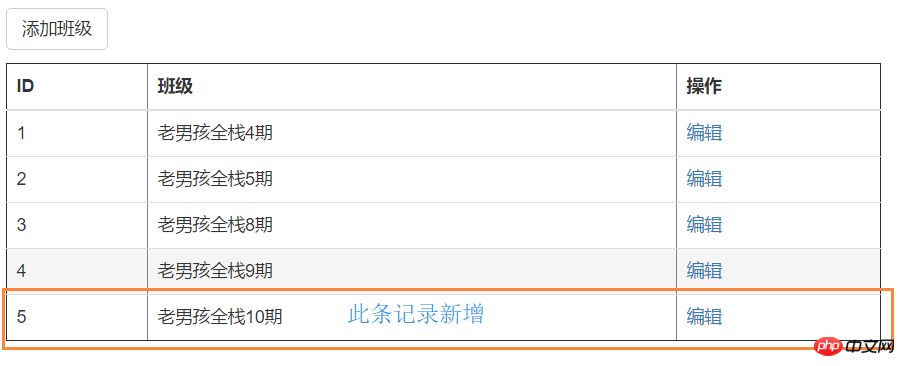
在教师表中新添加一名教师,发现无法获取上一步新增记录
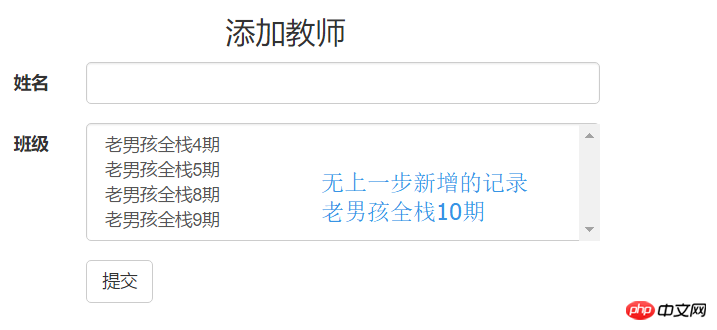
5. 原因分析
在添加教师时,请求方式为GET,html标签由Form组件自动生成,其中的数据也是由Form组件提供

而TchForm作为一个类,在project运行起来后,其中的name和t2c字段都是类的变量,其只执行一次,就将数据保存在内存中,无论之后生成多少个TchForm对象,其中的字段的值都不变。
所以会出现教师表中的班级多选列表无法动态更新。

二、解决上述bug的方法
每次更新数据库后重启project,让Form类重新初始化,能够让数据更新,但这显然是不切实际的。
知道了bug的根源,我们可以尝试让每次生成TchForm对象时就更新数据:
方法一
1. 利用 __init__将数据库操作放入对象变量中


1 #教师表单验证规则 2 class TchForm(Form): 3 name = fields.CharField(max_length=16, min_length=2, widget=widgets.TextInput(attrs={'class': 'form-control'})) 4 t2c = fields.MultipleChoiceField( 5 # choices=models.Classes.objects.values_list('id', 'title'), 6 widget=widgets.SelectMultiple(attrs={'class': 'form-control'}) 7 ) 8 9 def __init__(self, *args, **kwargs): # 自定义__init__10 super(TchForm, self).__init__(*args, **kwargs) # 调用父类的__init__11 self.fields['t2c'].choices = models.Classes.objects.values_list('id', 'title') # 为字段t2c的choices赋值2. 验证
在班级表中新增一条记录

再在教师表中添加
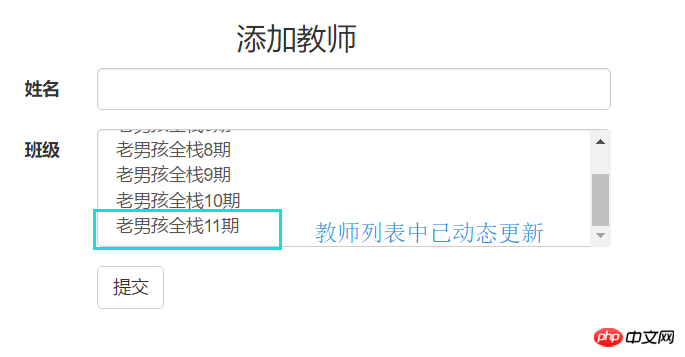
方法二
1. 利用django.forms.models模块中的queryset连接数据库


1 #教师表单验证规则 2 from django.forms import models as form_models # 导入django.forms.models 3 class TchForm(Form): 4 name = fields.CharField(max_length=16, min_length=2, widget=widgets.TextInput(attrs={'class': 'form-control'})) 5 #重新定义字段 6 t2c = form_models.ModelMultipleChoiceField( 7 # choices=models.Classes.objects.values_list('id', 'title'), 8 queryset=models.Classes.objects.all(), # 利用queryset连接数据库,只能连接object类型 9 widget=widgets.SelectMultiple(attrs={'class': 'form-control'})10 )2. 验证
由于TchForm类中,queryset只能连接object类型,所以,需要设置models.py中的Classes类的返回值。


1 class Classes(models.Model):2 title = models.CharField(max_length=32)3 4 def __str__(self):5 return self.title
在班级表中新增一条记录
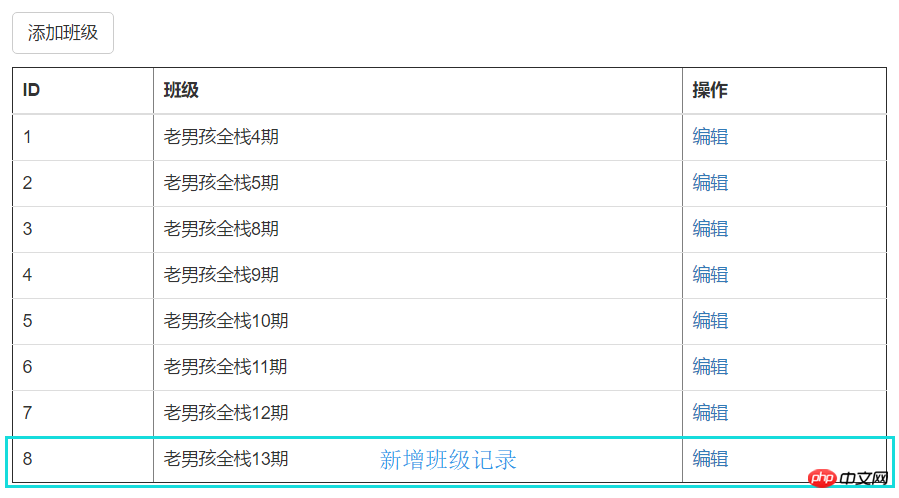
再在教师表中添加
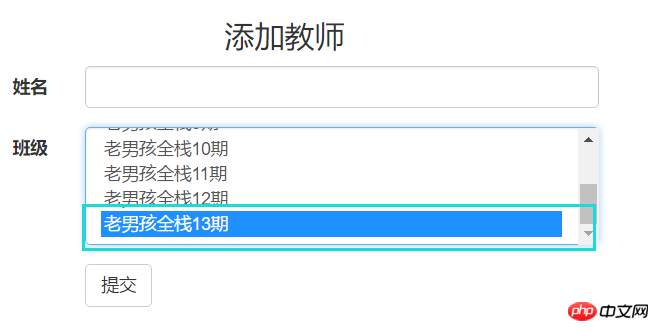
The above is the detailed content of Share two methods to solve the problem that Form form data cannot be refreshed dynamically.. For more information, please follow other related articles on the PHP Chinese website!

Hot AI Tools

Undresser.AI Undress
AI-powered app for creating realistic nude photos

AI Clothes Remover
Online AI tool for removing clothes from photos.

Undress AI Tool
Undress images for free

Clothoff.io
AI clothes remover

AI Hentai Generator
Generate AI Hentai for free.

Hot Article

Hot Tools

Notepad++7.3.1
Easy-to-use and free code editor

SublimeText3 Chinese version
Chinese version, very easy to use

Zend Studio 13.0.1
Powerful PHP integrated development environment

Dreamweaver CS6
Visual web development tools

SublimeText3 Mac version
God-level code editing software (SublimeText3)

Hot Topics
 How to check django version
Dec 01, 2023 pm 02:25 PM
How to check django version
Dec 01, 2023 pm 02:25 PM
Steps to check the Django version: 1. Open a terminal or command prompt window; 2. Make sure Django has been installed. If Django is not installed, you can use the package management tool to install it and enter the pip install django command; 3. After the installation is complete , you can use python -m django --version to check the Django version.
 Django vs. Flask: A comparative analysis of Python web frameworks
Jan 19, 2024 am 08:36 AM
Django vs. Flask: A comparative analysis of Python web frameworks
Jan 19, 2024 am 08:36 AM
Django and Flask are both leaders in Python Web frameworks, and they both have their own advantages and applicable scenarios. This article will conduct a comparative analysis of these two frameworks and provide specific code examples. Development Introduction Django is a full-featured Web framework, its main purpose is to quickly develop complex Web applications. Django provides many built-in functions, such as ORM (Object Relational Mapping), forms, authentication, management backend, etc. These features allow Django to handle large
 Django Framework Pros and Cons: Everything You Need to Know
Jan 19, 2024 am 09:09 AM
Django Framework Pros and Cons: Everything You Need to Know
Jan 19, 2024 am 09:09 AM
Django is a complete development framework that covers all aspects of the web development life cycle. Currently, this framework is one of the most popular web frameworks worldwide. If you plan to use Django to build your own web applications, then you need to understand the advantages and disadvantages of the Django framework. Here's everything you need to know, including specific code examples. Django advantages: 1. Rapid development-Djang can quickly develop web applications. It provides a rich library and internal
 How to check django version
Nov 30, 2023 pm 03:08 PM
How to check django version
Nov 30, 2023 pm 03:08 PM
How to check the django version: 1. To check through the command line, enter the "python -m django --version" command in the terminal or command line window; 2. To check in the Python interactive environment, enter "import django print(django. get_version())" code; 3. Check the settings file of the Django project and find a list named INSTALLED_APPS, which contains installed application information.
 What is the difference between django versions?
Nov 20, 2023 pm 04:33 PM
What is the difference between django versions?
Nov 20, 2023 pm 04:33 PM
The differences are: 1. Django 1.x series: This is an early version of Django, including versions 1.0, 1.1, 1.2, 1.3, 1.4, 1.5, 1.6, 1.7, 1.8 and 1.9. These versions mainly provide basic web development functions; 2. Django 2.x series: This is the mid-term version of Django, including 2.0, 2.1, 2.2 and other versions; 3. Django 3.x series: This is the latest version series of Django. Including versions 3.0, 3, etc.
 How to upgrade Django version: steps and considerations
Jan 19, 2024 am 10:16 AM
How to upgrade Django version: steps and considerations
Jan 19, 2024 am 10:16 AM
How to upgrade Django version: steps and considerations, specific code examples required Introduction: Django is a powerful Python Web framework that is continuously updated and upgraded to provide better performance and more features. However, for developers using older versions of Django, upgrading Django may face some challenges. This article will introduce the steps and precautions on how to upgrade the Django version, and provide specific code examples. 1. Back up project files before upgrading Djan
 Is django front-end or back-end?
Nov 21, 2023 pm 02:36 PM
Is django front-end or back-end?
Nov 21, 2023 pm 02:36 PM
django is the backend. Details: Although Django is primarily a backend framework, it is closely related to front-end development. Through features such as Django's template engine, static file management, and RESTful API, front-end developers can collaborate with back-end developers to build powerful, scalable web applications.
 How to use JavaScript to implement real-time verification of the input box content of a form?
Oct 18, 2023 am 08:47 AM
How to use JavaScript to implement real-time verification of the input box content of a form?
Oct 18, 2023 am 08:47 AM
How to use JavaScript to implement real-time verification of the input box content of a form? In many web applications, forms are the most common way of interaction between users and the system. However, the content entered by the user often needs to be validated to ensure the accuracy and completeness of the data. In this article, we will learn how to use JavaScript to implement real-time verification of the content of the form's input box and provide specific code examples. Creating the form First we need to create a simple table in HTML





